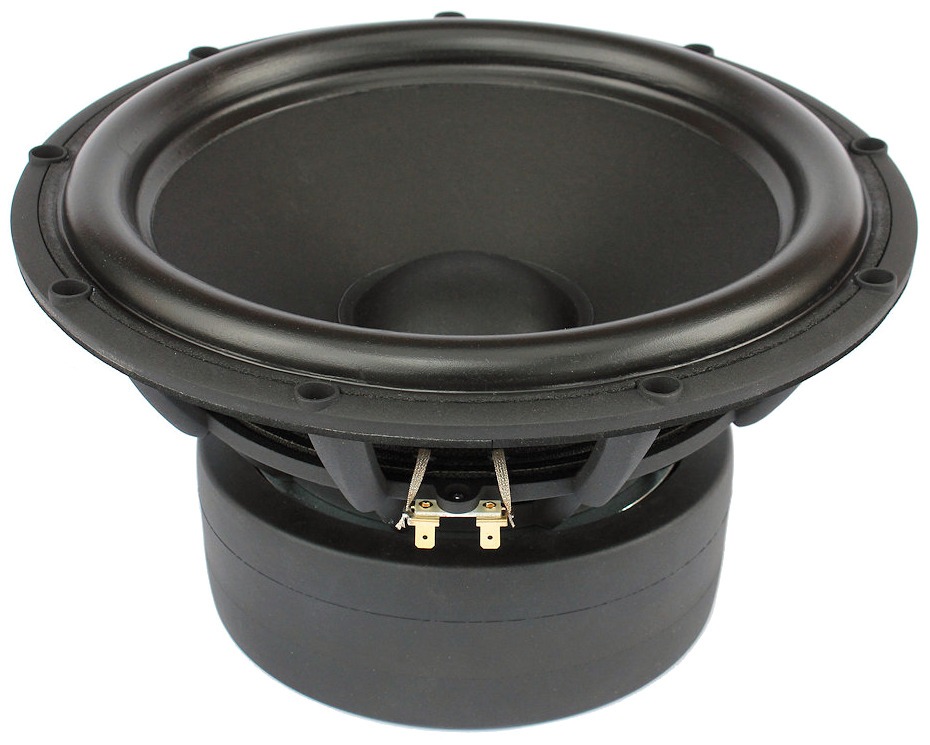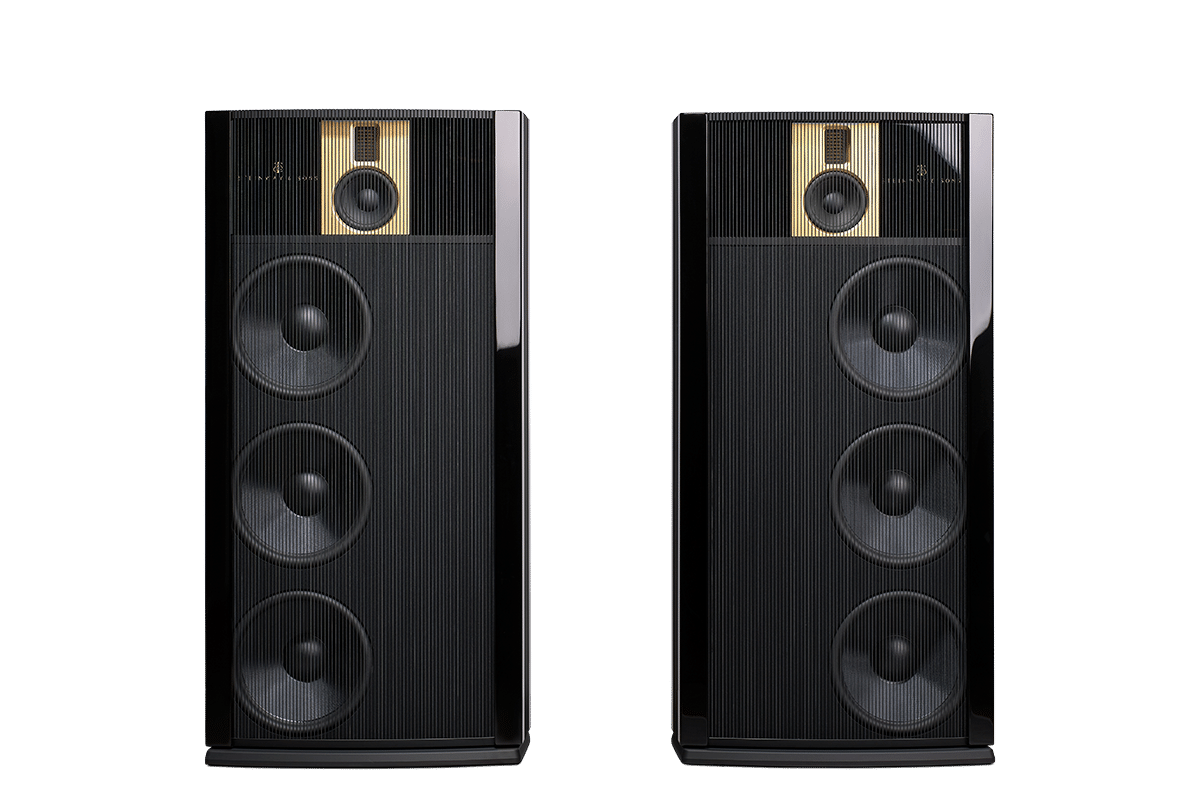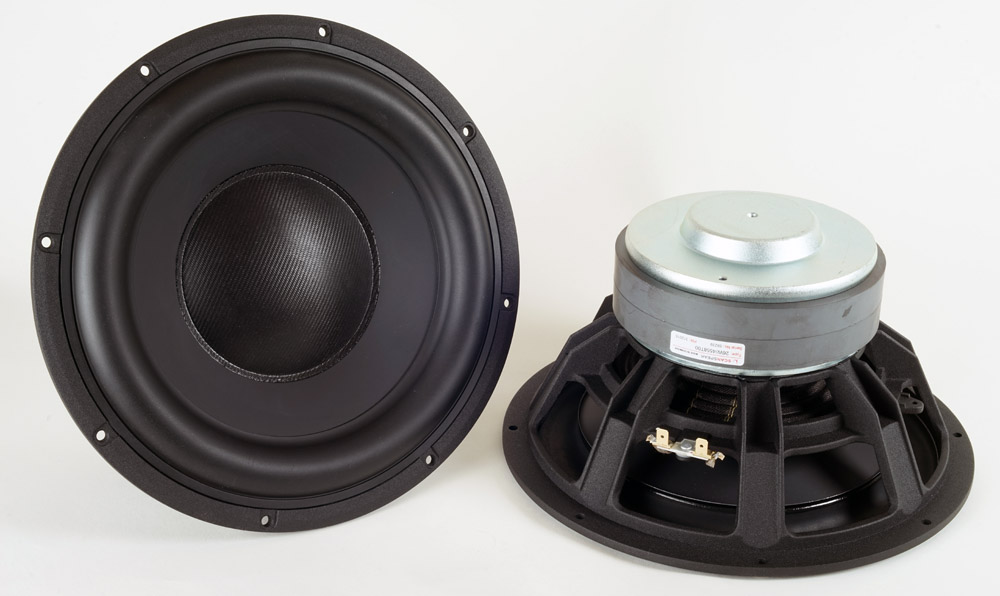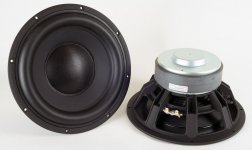That's going to take me a while longer. Still need to finish the inside of the enclosure, hookup the amp etc. and plan to run some impedance tests, driver by itself, driver in box, driver in box with damping added.
As said, I'll take my time, but slowly but surely I'll get there.
As said, I'll take my time, but slowly but surely I'll get there.
No traditional XO, I'll let the arrays run mostly full range, but try to use the subs for compensation where needed. They will do the first octave and then some, but I see it as working together to create a better whole. We'll see if I can make it work like that 🙂.
I'm hoping to improve a couple of points here. Even better left/right balance running lower than before (*). I'll use the subs to create some headroom/less movement for the tiny drivers.
(*) Right now the left array is compensating for the right array's weak points and vice versa. I'll try and have the subs do much of that heavy lifting.
I'm hoping to improve a couple of points here. Even better left/right balance running lower than before (*). I'll use the subs to create some headroom/less movement for the tiny drivers.
(*) Right now the left array is compensating for the right array's weak points and vice versa. I'll try and have the subs do much of that heavy lifting.
Last edited:
The only commercial sub I know about within the same ballpark is Paradigm Sub 2, I guess ..
Out of curiosity I looked up the Paradigm Sub 2 and even read a review...
Paradigm Reference Signature SUB 2 Subwoofer | Sound & Vision
Sounds like a plan to build something like that. Reading the review put a smile on my face. In there is the mention of the movie: A Christmas Carol, a movie I have viewed with my family quite a while ago. There's quite some sub-bass hidden in there and it even overloaded the arrays at that time.
It gave us quite a scare! Definitely a movie I will revisit when the subs are in place, hopefully this christmas. 😀
That Paradigm sub is a monster! Are you planning a similar setup with drivers on 3 of the 6 sides? Another example that an array of (smaller) drivers can do wonderful things. I couldn't believe how tiny that thing was!
Attachments
Last edited:
Yeah ... the sub 2 is as an awesome beast, but should be possible to make a sub that provides some of the same things... I believe there are not so many drivers that will make it as there is so many drivers in quite limited volume and most drivers will get underdamped and be very boomy.
I am looking for 9" to 10" drivers with high x-max, very low Qtc, limited Vas and not too high membrane weight....
There are some Morel and Scanspeak drivers that should be able to do it in a cabinet less than 140 liters and still be able to keep a Qtc under 0.6, so I would get a well damped bass and quite shallow rollof....
The challenge is that the drivers with this big magnets, bullet proof construction and high xmax are very expensive, and when you need 12 of them budget will easily pass € 8000, so as an experiment it can be pretty expensive but if it works well it's going to be awesome ....
of course, the complete insane build would be the one with 6 ScanSpeak/32W-878T11 but that would be pretty steep on budget and needs a box more than 160 liters I believe ....
On the other side, I reckon a sub with 6 of these on each side would be able to challenge any commerical sub on the market...
I just wonder how I would be able to fit such a beast, or actually.... two of them 😛

EDIT: Yes I am looking at alternatives for a hexagon subwoofer concept like the Paradigm sub 2 😛
Yes, The beauty is in the numbers, I recently listened to Steinway Lyngdorf Model B, which has 6 12" woofers on each side in a dipol... the dynamics and complete lack of compression at any level is stunning ....

I am looking for 9" to 10" drivers with high x-max, very low Qtc, limited Vas and not too high membrane weight....
There are some Morel and Scanspeak drivers that should be able to do it in a cabinet less than 140 liters and still be able to keep a Qtc under 0.6, so I would get a well damped bass and quite shallow rollof....
The challenge is that the drivers with this big magnets, bullet proof construction and high xmax are very expensive, and when you need 12 of them budget will easily pass € 8000, so as an experiment it can be pretty expensive but if it works well it's going to be awesome ....
of course, the complete insane build would be the one with 6 ScanSpeak/32W-878T11 but that would be pretty steep on budget and needs a box more than 160 liters I believe ....
On the other side, I reckon a sub with 6 of these on each side would be able to challenge any commerical sub on the market...
I just wonder how I would be able to fit such a beast, or actually.... two of them 😛

EDIT: Yes I am looking at alternatives for a hexagon subwoofer concept like the Paradigm sub 2 😛
Yes, The beauty is in the numbers, I recently listened to Steinway Lyngdorf Model B, which has 6 12" woofers on each side in a dipol... the dynamics and complete lack of compression at any level is stunning ....

Last edited:
I too dream of bass arrays. Then I think about whether my wife would let them into the living room and even if she did, would I be able to play them at volume and wake up.
For years I had Carver Amazing Platinum speakers with 4 12" OB woofers per side. The bass was indeed impressive despite the fact that for most of their life, I didn't have a room large enough to do them justice. Sealed would have been better in those rooms. I should note that these woofers weren't a high excursion design.
I would do my experiments with inexpensive woofers if I went past the dreaming stage. When you have a lot of them, you don't need high excursion, witness the arrays themselves. I have simulated 16 (8 per side but 9 would work well in a 3 sided array) Dayton DC-200 8" woofers in a total of 100L and a Q of 1.32 equalized for -3db at 20 Hz in 1pi space using only 70W and 4mm of excursion. The most attractive thing about these woofers is their $24 price but with so many you don't need to ask a lot of them.
For years I had Carver Amazing Platinum speakers with 4 12" OB woofers per side. The bass was indeed impressive despite the fact that for most of their life, I didn't have a room large enough to do them justice. Sealed would have been better in those rooms. I should note that these woofers weren't a high excursion design.
I would do my experiments with inexpensive woofers if I went past the dreaming stage. When you have a lot of them, you don't need high excursion, witness the arrays themselves. I have simulated 16 (8 per side but 9 would work well in a 3 sided array) Dayton DC-200 8" woofers in a total of 100L and a Q of 1.32 equalized for -3db at 20 Hz in 1pi space using only 70W and 4mm of excursion. The most attractive thing about these woofers is their $24 price but with so many you don't need to ask a lot of them.
How small was the room, why would sealed have been better?For years I had Carver Amazing Platinum speakers with 4 12" OB woofers per side. The bass was indeed impressive despite the fact that for most of their life, I didn't have a room large enough to do them justice. Sealed would have been better in those rooms. I should note that these woofers weren't a high excursion design.
Open baffle woofers can obviously work quite well pretty close to room boundaries, when I auditioned the Steinway Lyngdorf model B they were pretty close to the front wall, Peter Lyngdorf himself was there stating that it's not a problem to have them 50 cm from front wall...
Think it would be pretty interesting excercise to mate full-range line source with a set of OB woofers 😛
The sheer crazy dynamics of good OB woofers is stunning
Or.... is my thinking going completely haywire here 😀
Think it would be pretty interesting excercise to mate full-range line source with a set of OB woofers 😛
The sheer crazy dynamics of good OB woofers is stunning
Or.... is my thinking going completely haywire here 😀
Last edited:
12' x 20' and crowded with computer tech.
They never sounded as good as they did in my original huge open space home.
In hindsight they suffered from the backwave bouncing off the front wall and coming forward to disrupt the dipole pattern and also contributing early reflections. But this is just hindsight, knowing what I know now. I was happy with them then, not yet into DIY.
With sealed, I would not have had the backwave to deal with and with some absorption behind the ribbons, could have placed them tight against the wall. For example, that 8x 8" array I mentioned only needs to be 4" thick inside dimension.
They never sounded as good as they did in my original huge open space home.
In hindsight they suffered from the backwave bouncing off the front wall and coming forward to disrupt the dipole pattern and also contributing early reflections. But this is just hindsight, knowing what I know now. I was happy with them then, not yet into DIY.
With sealed, I would not have had the backwave to deal with and with some absorption behind the ribbons, could have placed them tight against the wall. For example, that 8x 8" array I mentioned only needs to be 4" thick inside dimension.
Peter Lyngdorf's core statement is that a dipol sound better because the reflections coming off the wall sounds as good as the front facing signal... as long as the first refelctions are controlled and within a limitation of 15ms (I believe it is) the ear will integrate it into one sound wave...
The problem according to Lyngdorf is that with regular speakers the signal coming off the back sounds like crap and the reflections will have a completely different signature than the direct waves.... messing up the total experienced acoustic experience
Again, listening to Peter Lyngdorf's dipol designs, it is not difficult to agree with him 😛
(But I am on the normal speaker route still....... maybe 😛 )
The problem according to Lyngdorf is that with regular speakers the signal coming off the back sounds like crap and the reflections will have a completely different signature than the direct waves.... messing up the total experienced acoustic experience
Again, listening to Peter Lyngdorf's dipol designs, it is not difficult to agree with him 😛
(But I am on the normal speaker route still....... maybe 😛 )
Last edited:
Yes, it's mainly down to the delay of the first reflection, 6mS I believe is the minimum (approx 3 feet from front wall), and constant directivity. I don't think a room can be too small so long as this can be achieved, as far as LF is concerned, all rooms are small 🙂
Much, if not all, depends on what you mean with bass; in other words: what is the frequency range of your OB bass?
In 15 ms sound travels over 5 meters...
By definition, open baffle bass is restricted; front and back waves cancel depending on frequency.
I never heard open baffle bass able to reproduce real low bass, it is simply not possible (despite equalization).
It is just what you want and with what you are satisfied.
Open baffle bass might be OK for solo piano, or small scale music without too much low frequency content.
In case you want "full frequency" sound of an orchestra, providing you with real bass impact (and acoustical information related to low frequency), open baffle bass is not able to do that.
In 15 ms sound travels over 5 meters...
By definition, open baffle bass is restricted; front and back waves cancel depending on frequency.
I never heard open baffle bass able to reproduce real low bass, it is simply not possible (despite equalization).
It is just what you want and with what you are satisfied.
Open baffle bass might be OK for solo piano, or small scale music without too much low frequency content.
In case you want "full frequency" sound of an orchestra, providing you with real bass impact (and acoustical information related to low frequency), open baffle bass is not able to do that.
Don't forget that part of their (Paradigm) success probably comes from it's specific processing. At least that's how I interpret the results in that review. The advantage of using that many cones is that it will be harder to "overplay" them as a result. They can do what you ask of them, but might need a bit of help to do so.
Don't be afraid to pick drivers with generous x-max and low mass cones that might not keep everything you look for. You can process them, much like a Linkwitz transform to play lower than they would, given the volume etc. as long as that volume is sealed. Processing bass inside the room based on averages to circumvent room anomalies can be done. That gives you the bass that does what that review states. Well defined and with detail. As soon as you find something that works inside the room you loose any boomy bass factor.
I'd look at the Scan Speak 26W for this job. If it is good enough for a monster project like the Beolab 90, an insane speaker project, and you use 6 of them with processing you should get plenty! Even better if you use 2 of those subs in total 😀.
I was re-assured by their use of the 26W in such a high prestige speaker. I've looked at pictures until I found one that confirmed it was indeed the 26W that was used.
I wasn't able to tell (for sure) from this picture:

But when I found some evidence they used a Discovery 26W for that top dollar product, I figured the 30W was going to be good enough for me.

Source is this video at 1:08 on timeline: YouTube
That closed magnet back can only mean it is indeed the 26W.

Even though I now had evidence I still compared all reviews and measurements I could find on both the 30W and 32W. But in the end I am convinced its going to be the added volume displacement together with the room placement and processing that will lead to success. That's why I want the array and sub to "play well together", instead of just handing over that job. Multi-sub works for a reason, figure out why and you're well on your way.
(Sure I still lust for that 32W 😀. I even sized the cabinets for a possible fit down the road. 😱)
Don't be afraid to pick drivers with generous x-max and low mass cones that might not keep everything you look for. You can process them, much like a Linkwitz transform to play lower than they would, given the volume etc. as long as that volume is sealed. Processing bass inside the room based on averages to circumvent room anomalies can be done. That gives you the bass that does what that review states. Well defined and with detail. As soon as you find something that works inside the room you loose any boomy bass factor.
I'd look at the Scan Speak 26W for this job. If it is good enough for a monster project like the Beolab 90, an insane speaker project, and you use 6 of them with processing you should get plenty! Even better if you use 2 of those subs in total 😀.
I was re-assured by their use of the 26W in such a high prestige speaker. I've looked at pictures until I found one that confirmed it was indeed the 26W that was used.
I wasn't able to tell (for sure) from this picture:
But when I found some evidence they used a Discovery 26W for that top dollar product, I figured the 30W was going to be good enough for me.
Source is this video at 1:08 on timeline: YouTube
That closed magnet back can only mean it is indeed the 26W.
Even though I now had evidence I still compared all reviews and measurements I could find on both the 30W and 32W. But in the end I am convinced its going to be the added volume displacement together with the room placement and processing that will lead to success. That's why I want the array and sub to "play well together", instead of just handing over that job. Multi-sub works for a reason, figure out why and you're well on your way.
(Sure I still lust for that 32W 😀. I even sized the cabinets for a possible fit down the road. 😱)
Attachments
Last edited:
There is of course the obvious case of cancellation happening with OB bass, but in the case of the Steinway Lyngdorf's, which is only 60 cm wide they go pretty low... it is stated approaching 25 Hz; I am not sure how that is physically possible ... listening to some variations of classical music, I can't say I miss anything, in the low end; This is, however, just with a short demo. Maybe church organs would prove severe limitations
I should be more careful about how I phrase things to avoid controversy or upset.
My general feeling is that small sealed works better in a small room. The primary reason I started down the DIY path was to design speakers to work tight to room boundaries because of the room size constraints I faced.
Look at the boundary and early reflection issues - you really want the speakers 2m out and away. 2m from front wall gives about 12 ms reflection delay. At that level of delay it begins to be not early. Less is a compromise but not one that you can't live with. There are worse things in audio reproduction.
In a sense I agree with Peter L. If you can't have the speakers well away from the walls, then place them as close as possible (and treat the walls) so the delay is small enough to integrate with the direct sound and support it down low. But won't a short delay reflection f the signal from the back of an OB off the front wall cancel the direct wave down low? It will be almost 180 degrees out of phase.
My general feeling is that small sealed works better in a small room. The primary reason I started down the DIY path was to design speakers to work tight to room boundaries because of the room size constraints I faced.
Look at the boundary and early reflection issues - you really want the speakers 2m out and away. 2m from front wall gives about 12 ms reflection delay. At that level of delay it begins to be not early. Less is a compromise but not one that you can't live with. There are worse things in audio reproduction.
In a sense I agree with Peter L. If you can't have the speakers well away from the walls, then place them as close as possible (and treat the walls) so the delay is small enough to integrate with the direct sound and support it down low. But won't a short delay reflection f the signal from the back of an OB off the front wall cancel the direct wave down low? It will be almost 180 degrees out of phase.
- Home
- Loudspeakers
- Full Range
- The making of: The Two Towers (a 25 driver Full Range line array)

